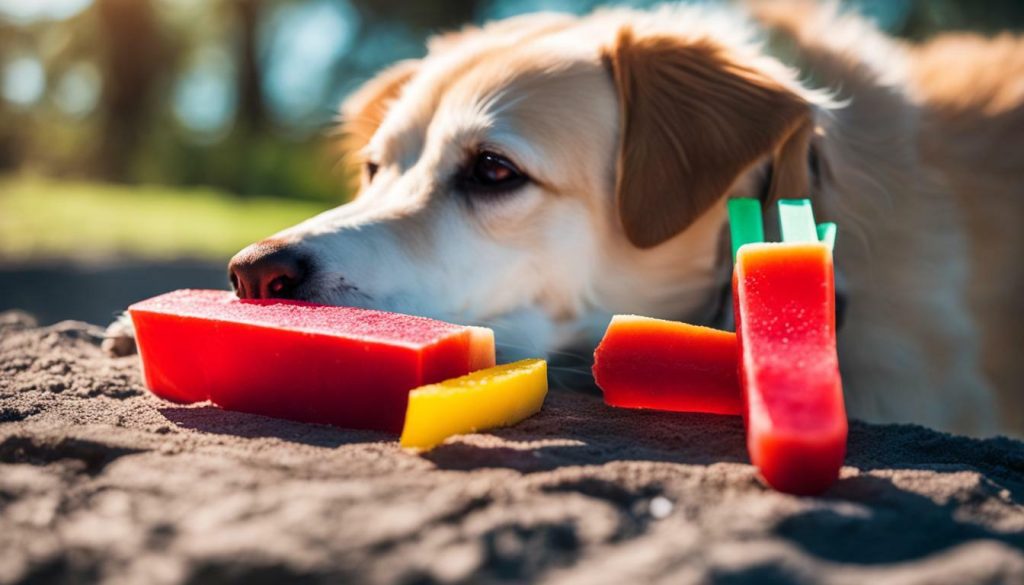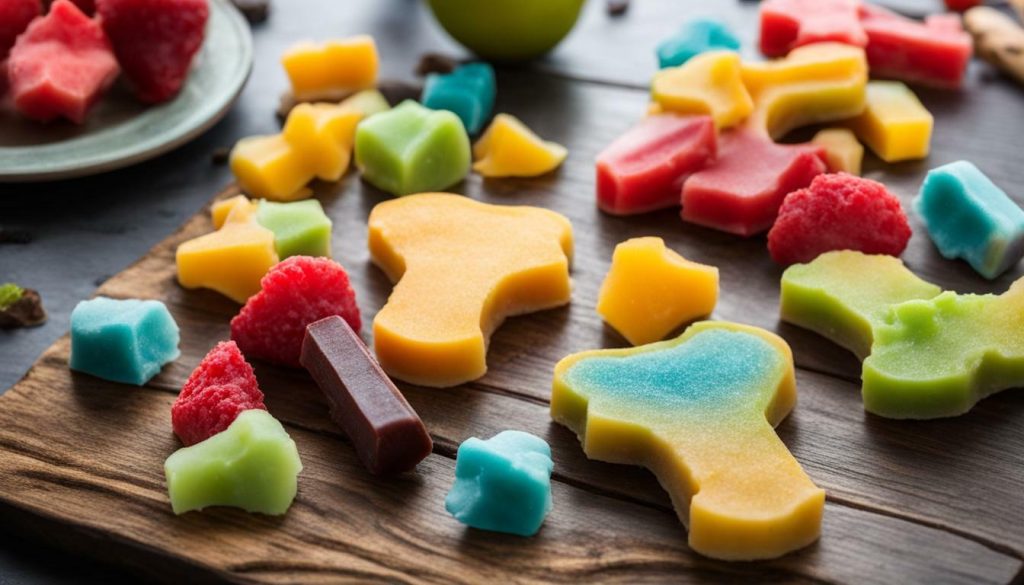
Many pet owners wonder, “Can dogs eat popsicles?” Let’s dive into this sweet topic and shed light on whether popsicles are safe for our canine companions.
- Dogs can eat popsicles, but not all popsicles are safe for them.
- Manufactured popsicles often contain ingredients that can cause gastrointestinal upset in dogs, such as dairy products, artificial sweeteners like xylitol, macadamia nuts, raisins, and chocolate.
- Homemade popsicles using dog-safe fruits like apples or bananas are a better option.
- Moderation is crucial to prevent obesity, as too many treats can lead to weight gain.
- Frozen treats can help keep dogs cool and provide mental stimulation.
When it comes to popsicles, it’s best to avoid those made for humans and instead opt for dog-specific frozen treats or homemade options. Always check the ingredients to ensure they are safe for your furry friend. Popsicles containing xylitol, artificial ingredients, and excessive amounts of sugar should be avoided. Additionally, be cautious of popsicle sticks, as they can be dangerous if ingested.
By being informed and cautious, we can safely treat our dogs to the occasional popsicle delight, making summer days even more enjoyable for our four-legged companions.
Understanding the Risks of Popsicles for Dogs
While popsicles may seem like a refreshing treat for dogs, it’s essential to understand the potential risks they can pose to our canine friends. Not all popsicles are safe for dogs to consume, as many commercial varieties contain ingredients that can be harmful or cause gastrointestinal upset.
Manufactured popsicles often contain dairy products, artificial sweeteners, and flavorings that can be problematic for dogs. For example, artificial sweeteners like xylitol, which are commonly used in sugar-free popsicles, can be toxic to dogs and lead to a dangerous drop in blood sugar levels. Additionally, ingredients like macadamia nuts, raisins, and chocolate are highly toxic to dogs and can cause severe health issues if ingested.
To ensure the safety of our furry friends, it’s best to opt for dog-specific frozen treats or homemade popsicles using dog-safe ingredients. Fruits such as apples or bananas can be blended and frozen to create a refreshing and safe treat for dogs. By avoiding popsicles made for humans and being mindful of the ingredients, we can provide our dogs with a delicious and safe cold treat during hot weather.

When giving dogs popsicles, it’s important to practice moderation. While frozen treats can be beneficial for keeping dogs cool and providing mental stimulation, too many treats can contribute to obesity and other health issues. Maintaining a balanced diet and offering popsicles as occasional treats ensures that dogs receive the benefits without any negative effects.
Lastly, it’s crucial to keep popsicle sticks away from our furry friends. Popsicle sticks can be dangerous if ingested, leading to choking, intestinal blockages, or other injuries. Always supervise your dog when enjoying a popsicle and dispose of the stick properly to prevent any accidents.
Harmful Ingredients in Popsicles for Dogs
Some commonly used ingredients in popsicles, such as artificial sweeteners, macadamia nuts, raisins, and chocolate, can be toxic or cause digestive issues for dogs. It’s important to be aware of these ingredients and their potential dangers when considering giving popsicles to your furry friend.
Artificial sweeteners, such as xylitol, are often found in sugar-free popsicles. While they may be safe for humans, xylitol can be highly toxic to dogs, causing a rapid release of insulin and leading to low blood sugar levels. This can result in symptoms like lethargy, vomiting, seizures, and even liver failure.
Macadamia nuts, commonly used in some popsicle recipes, can also be harmful to dogs. These nuts contain a toxin that can affect a dog’s nervous system, leading to weakness, tremors, and hyperthermia. Ingesting even a small amount of macadamia nuts can cause these symptoms to occur.

Raisins and grapes, another potentially dangerous ingredient, can cause kidney failure in dogs. Even a small amount can lead to severe toxicity, leading to symptoms like vomiting, diarrhea, lack of appetite, and decreased urine production.
Chocolate is well-known for being toxic to dogs. Theobromine, a compound found in chocolate, can cause various symptoms in dogs, ranging from gastrointestinal upset to heart problems, muscle tremors, and seizures. The darker the chocolate, the higher the concentration of theobromine, and the more dangerous it is for dogs.
Homemade Popsicles: A Safer Alternative
If you’re looking for a safer option, homemade popsicles using dog-friendly ingredients can be a great way to treat your canine companion. By making your own frozen treats, you have complete control over the ingredients, ensuring that they are safe and suitable for your dog’s consumption. Plus, it can be a fun and creative activity for both you and your furry friend!
Start by selecting dog-friendly ingredients such as apples, bananas, berries, or even plain yogurt. These ingredients are not only tasty but also offer nutritional benefits for your dog. Avoid using artificial sweeteners, as they can be toxic to dogs. Remember, moderation is key when it comes to treats, so don’t go overboard on the portion sizes.
To make homemade popsicles, simply blend or mash the chosen ingredients together until you have a smooth mixture. You can then pour the mixture into popsicle molds or ice cube trays, and insert a dog-friendly stick in the center. Freeze the treats for a few hours or overnight until they are solid. And voila, you have homemade popsicles ready to be enjoyed by your furry friend!
Homemade Popsicle Recipe for Dogs
If you’re looking for a quick and easy recipe, try this dog-friendly popsicle:
- Ingredients:
- 1 ripe banana
- 1 cup plain yogurt
- Instructions:
- Mash the ripe banana until smooth.
- Combine the mashed banana with the plain yogurt.
- Pour the mixture into popsicle molds or ice cube trays.
- Insert a dog-safe stick into each mold or tray.
- Freeze for a few hours or overnight until solid.
- Serve the frozen treats to your dog and watch their tail wag with delight!
Remember to always supervise your dog while they enjoy their frozen treats. If your dog has any specific health conditions or allergies, it’s best to consult with your veterinarian before introducing homemade popsicles into their diet. Homemade popsicles can provide a fun and refreshing way to keep your dog cool during hot summer days while ensuring their safety and well-being.

| Benefits of Homemade Popsicles for Dogs: |
|---|
| 1. Safe and dog-friendly ingredients. |
| 2. Nutritional value from fresh fruits and yogurt. |
| 3. Control over portion sizes and ingredients. |
| 4. Enjoyment and enrichment for your dog. |
Moderation and Health Considerations
While dogs can enjoy popsicles, it’s crucial to remember that moderation is key, and their overall diet should be balanced for optimal health. Treats, including frozen ones, should only make up a small portion of a dog’s daily calorie intake. Overindulging in popsicles or any treats can lead to weight gain and obesity, which can have negative impacts on a dog’s overall well-being.
When giving your dog popsicles or frozen treats, it’s important to consider their specific health needs and any dietary restrictions they may have. Some dogs may have food intolerances or allergies to certain ingredients commonly found in popsicles, such as dairy products or artificial sweeteners like xylitol. Always check the ingredient list and consult with your veterinarian if you’re unsure about the safety of a specific popsicle.
One way to ensure a healthier option is by making homemade popsicles using dog-safe ingredients. Fruits like apples or bananas are a great choice, as they are generally well-tolerated by dogs and offer added nutritional benefits. There are numerous recipes available online that use these ingredients, allowing you to control what goes into your dog’s frozen treats.
| Benefits of Moderation and Healthy Frozen Treats: |
|---|
| – Helps prevent obesity and weight gain |
| – Reduces the risk of gastrointestinal upset from harmful ingredients |
| – Provides mental stimulation and enrichment |
| – Keeps dogs cool during hot weather |
Remember, frozen treats should supplement a balanced diet and not replace regular meals. Always consult with your veterinarian before introducing any new treats or altering your dog’s diet. With moderation, careful ingredient selection, and consideration for your dog’s unique health needs, popsicles and frozen treats can be a delightful and safe addition to their occasional indulgences.

Frozen treats, including popsicles, can offer several benefits to dogs, such as keeping them cool and providing entertainment and enrichment. When the weather gets hot, dogs can easily become overheated, and frozen treats can help regulate their body temperature. The cold sensation of a popsicle can provide relief and prevent heatstroke, especially for dogs with thick coats or those prone to overheating.
In addition to keeping dogs cool, frozen treats can also provide mental stimulation. Dogs love to chew and lick, and a frozen popsicle can provide hours of entertainment. It can help alleviate boredom and keep their minds occupied, especially during times when they may be left alone or confined indoors.

My dog absolutely loves frozen treats! It’s a great way to keep her entertained and give her something to do on hot summer days. I like to make my own popsicles using dog-friendly ingredients like bananas and yogurt. It’s a fun and healthy way to treat her and ensure she stays cool in the heat.
When choosing frozen treats for your dog, it’s important to select options that are specifically made for dogs. Human popsicles often contain ingredients that can be harmful to dogs, such as artificial sweeteners like xylitol or high amounts of sugar. Dog-specific frozen treats are formulated with canine health in mind, ensuring they are safe and nutritious.
In conclusion, frozen treats, including popsicles, can be a fantastic way to keep your dog cool and entertained during the hot summer months. However, it’s crucial to be mindful of the ingredients and choose options that are safe for dogs. Homemade treats using dog-friendly ingredients or dog-specific frozen treats are the best choices. Remember to offer these treats in moderation and always keep an eye on your dog while they enjoy their frozen delight!
Choosing Dog-Specific Frozen Treats
When it comes to frozen treats for dogs, it’s best to opt for options specifically designed for their dietary needs and safety. While it may be tempting to give your furry friend a taste of your own popsicle, many human treats contain ingredients that could be harmful to dogs. By choosing dog-specific frozen treats, you can ensure that your pet receives a delicious and safe treat.
Dog-specific frozen treats are formulated with ingredients that are safe and healthy for dogs to consume. They are often made with natural, dog-friendly fruits and vegetables that provide both flavor and nutritional benefits. These treats are carefully crafted to meet your dog’s dietary needs, taking into account any specific allergies or intolerances they may have.
Another advantage of dog-specific frozen treats is that they are free from artificial sweeteners like xylitol, which can be toxic to dogs. By avoiding these potentially dangerous ingredients, you can have peace of mind knowing that you are giving your dog a treat that won’t harm their health.

When shopping for dog-specific frozen treats, look for products that are made from high-quality, natural ingredients. You can also consider making your own homemade frozen treats using dog-safe fruits such as apples or bananas. By making your own treats, you have full control over the ingredients and can cater to your dog’s preferences.
Remember, moderation is key when it comes to treating your dog to frozen delights. While it’s tempting to spoil them with treats, too many can lead to weight gain and other health issues. A balanced diet is important for your dog’s overall well-being, so be mindful of the number of frozen treats you offer.
| Frozen Treat Options for Dogs: |
|---|
| 1. Dog-specific frozen treats |
| 2. Homemade frozen treats using dog-safe fruits |
Warning Signs and Precautions
It’s important to recognize warning signs of adverse reactions and take precautions to keep your dog safe, such as avoiding popsicles with xylitol and high sugar content. Xylitol, a common artificial sweetener used in many popsicles, can be extremely toxic to dogs and may lead to low blood sugar, seizures, liver failure, and even death. High sugar treats can contribute to obesity, diabetes, and dental issues in dogs. As a responsible pet owner, it’s crucial to carefully read the ingredient labels and avoid any popsicles that contain these harmful substances.
Aside from xylitol and high sugar content, it’s also essential to be vigilant for other potential ingredients that can be harmful to dogs. Chocolate, macadamia nuts, and raisins, often found in popsicles, are known to be toxic to dogs and can cause symptoms such as vomiting, diarrhea, tremors, and in severe cases, organ failure. If you suspect your dog has ingested any of these toxic substances, it’s crucial to seek immediate veterinary care.
To protect your furry friend, consider opting for dog-specific frozen treats or homemade popsicles using dog-safe ingredients. By making your own popsicles, you have control over what goes into them and can ensure they are free from harmful additives. Dog-safe fruits like apples, bananas, and watermelon can be frozen into refreshing treats that your dog will enjoy. Remember to remove any seeds, pits, or skins before freezing the fruits.

When offering your dog popsicles, always do so in moderation. Too many treats, even if they are safe and healthy, can lead to weight gain and other health issues. Additionally, it’s important to consider your dog’s overall diet and ensure that popsicles or other frozen treats are incorporated as an occasional indulgence rather than a regular part of their daily meals.
Table: Common Harmful Ingredients in Popsicles
| Ingredient | Potential Harm to Dogs |
|---|---|
| Xylitol | Low blood sugar, seizures, liver failure |
| Chocolate | Vomiting, diarrhea, tremors, organ failure |
| Macadamia Nuts | Weakness, tremors, vomiting, hyperthermia |
| Raisins | Vomiting, diarrhea, kidney failure |
Lastly, it’s important to note that popsicle sticks can pose a hazard if ingested by dogs. They can cause choking, digestive blockages, or even internal injuries. Always ensure that popsicles are consumed under supervision and dispose of the sticks immediately to prevent any accidents.
Homemade Popsicle Recipes for Dogs
Get creative in the kitchen with these homemade popsicle recipes that are not only safe for your dog but also delicious and refreshing. Making your own frozen treats allows you to control the ingredients and ensure they are suitable for your furry friend. Plus, it’s a fun and interactive way to bond with your pet!
Here are three simple and healthy recipes that your dog will love:
- Fruity Pupsicles: Blend together your dog’s favorite fruits, such as apples, watermelon, and blueberries. Pour the mixture into popsicle molds or ice cube trays and insert a small dog treat or piece of fruit as a surprise in the center. Freeze overnight and serve on a hot day for a refreshing snack.
- Peanut Butter Delight: Mix together natural unsalted peanut butter with plain Greek yogurt. Add a touch of honey for sweetness, if desired. Pour the mixture into molds or ice cube trays and freeze until solid. Your dog will be licking their lips for these tasty treats!
- Chicken Broth Pops: Dilute low-sodium chicken broth with water and pour it into molds or ice cube trays. Drop a few small dog treats into each mold for added flavor. Freeze and give your pup a savory and soothing popsicle to enjoy.
Remember to remove the popsicle from the mold or tray before giving it to your dog to prevent any choking hazards. Always supervise your dog while they enjoy their homemade popsicle, especially if they like to chew on things quickly. These treats should be given in moderation as part of a balanced diet.

So, why not beat the heat and treat your furry companion to a homemade popsicle? They’ll appreciate the effort and love the taste of these dog-friendly frozen delights!
The Dangers of Popsicle Sticks
While enjoying popsicles, it’s important to be cautious of the dangers associated with popsicle sticks and take measures to keep them out of your dog’s reach. Dogs may be tempted to chew on or even swallow popsicle sticks, which can lead to serious health issues. Popsicle sticks pose a choking hazard and can cause blockages in the digestive system. If ingested, they can cause tearing or perforation of the intestines, requiring immediate veterinary attention.
To prevent accidents, it’s essential to supervise your dog while they enjoy frozen treats and promptly discard popsicle sticks in secure trash bins. Avoid leaving popsicles unattended, especially in areas accessible to your furry friend. Additionally, it’s helpful to provide alternative chew toys, like sturdy rubber or nylon bones, to satisfy your dog’s natural urge to chew.
If you suspect that your dog has ingested a popsicle stick, be vigilant for warning signs such as vomiting, diarrhea, abdominal pain, loss of appetite, or changes in behavior. These could indicate a potential emergency situation. It’s crucial to contact your veterinarian immediately for guidance and follow their instructions to ensure your dog’s safety and well-being.
| Risk Factors | Prevention Tips |
|---|---|
| Choking hazard | Keep popsicle sticks out of reach and promptly dispose of them |
| Intestinal blockage | Supervise your dog while they have popsicles and provide appropriate chew toys |
| Tearing or perforation of intestines | Seek immediate veterinary attention if ingestion occurs |
By being aware of the risks associated with popsicle sticks and taking necessary precautions, you can ensure your dog’s safety while still enjoying frozen treats. Remember, always prioritize your dog’s well-being and consult with your veterinarian if you have any concerns.

“Prevention is the key when it comes to popsicle sticks and dogs. Keep them safely stored away and avoid potential hazards for your furry companion.” – Dr. Emily Thompson, Veterinarian
Conclusion
While dogs can enjoy popsicles, it’s crucial for pet owners to be aware of the risks and make informed choices to ensure the safety and well-being of their furry friends. Not all popsicles are safe for dogs, as many commercially available options contain ingredients that can cause gastrointestinal upset and even be toxic to dogs. Dairy products, artificial sweeteners like xylitol, macadamia nuts, raisins, and chocolate are a few examples of potentially harmful ingredients.
To provide a safer alternative, pet owners can opt for homemade popsicles using dog-safe fruits like apples or bananas. By preparing frozen treats at home, you have control over the ingredients and can avoid potential dangers. However, it’s important to remember that moderation is key. Too many treats, including popsicles, can lead to obesity and other health issues in dogs.
In addition to keeping dogs cool during hot weather, frozen treats can also provide mental stimulation and enrichment. However, it’s crucial to choose frozen treats specifically made for dogs or use homemade options. Human popsicles often contain artificial ingredients, high amounts of sugar, and potentially toxic sweeteners like xylitol, which can be extremely dangerous for dogs.
Lastly, it’s essential to keep popsicle sticks away from dogs as they can pose a choking hazard or cause blockages if ingested. Always supervise your dog when enjoying frozen treats to prevent accidents and promptly address any warning signs of discomfort or adverse reactions. By being mindful of the ingredients and taking precautions, you can ensure that your furry friend can safely enjoy a refreshing treat without any harm.
FAQ
Can dogs eat popsicles?
Dogs can eat popsicles, but not all popsicles are safe for them. It’s important to be aware of the ingredients and your dog’s intolerances and allergies.
What ingredients in popsicles can be harmful to dogs?
Many manufactured popsicles contain ingredients that can cause gastrointestinal upset, such as dairy products, artificial sweeteners like xylitol, macadamia nuts, raisins, and chocolate.
Are homemade popsicles a safer alternative for dogs?
Yes, homemade popsicles using dog-safe fruits like apples or bananas are a better option. It allows you to have control over the ingredients and avoid harmful additives.
Can dogs have too many popsicles?
Yes, moderation is key. Too many treats, including popsicles, can lead to obesity and other health issues. It’s important to provide a balanced diet for your dog.
What are the benefits of frozen treats for dogs?
Frozen treats can help keep dogs cool during hot weather and provide mental stimulation. They can also be used as a reward or enrichment activity for your furry friend.
Should I choose dog-specific frozen treats over human popsicles?
Yes, it’s best to avoid popsicles made for humans and opt for dog-specific frozen treats or homemade options. This ensures that the ingredients are safe and suitable for dogs.
What should I do if my dog ingests a popsicle stick?
Popsicle sticks can be dangerous if ingested. It’s important to keep them away from dogs. If ingestion occurs, contact your veterinarian for guidance.






